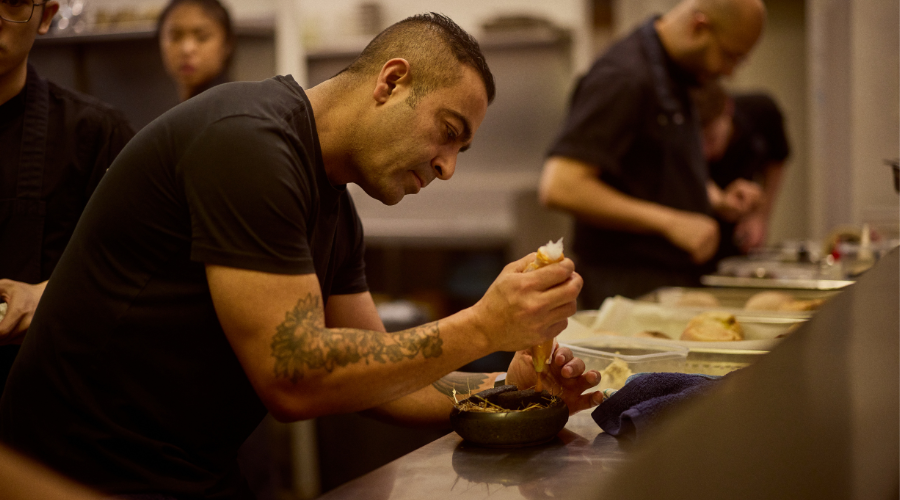What could Indian and Kiwi cuisines possibly have in common? At first glance, not much. But Chef Sid Sahrawat, one of New Zealand’s most celebrated chefs, is here to challenge that assumption. Based in Auckland, Sahrawat has been a trailblazer in modern New Zealand cuisine through his acclaimed restaurant, Sidart. Yet, his deep-rooted love for Indian flavours remains ever-present, most notably at his award-winning restaurant, Cassia.
In an exclusive conversation with Outlook Traveller Eats, Sahrawat shares how his Indian heritage and Kiwi surroundings have come together to shape a distinctive culinary style. He opens up about his journey from India to the top kitchens of New Zealand, the unexpected harmony between the two food cultures, and what exciting ventures lie ahead.
Sahrawat’s Journey
Sahrawat’s journey began in 1994 with a three-year course in hotel management in Chennai. After completing the program, he moved to the Middle East and secured an apprenticeship at the Grand Hyatt Muscat. “The Middle East was great, but most produce is imported, and I was looking for a change,” he said.
That change came when his mother was offered a job in Wellington, and he relocated with her. “Australia has great indigenous and original produce, unlike the Middle East,” he added.
Between 2000 and 2009, Sahrawat worked at various restaurants across New Zealand. One notable stint was as head chef at The Grove, a highly rated restaurant that earned several accolades during his tenure.
“Before you start your own space, it’s crucial to understand your style,” he explained. He describes his culinary approach as global, eclectic, and boundary-pushing. When asked about one of his most unconventional creations, he replied, “A blue cheese ice cream.”
In New Zealand, a 10-course meal typically includes a cheese course before dessert. Sahrawat combined the two, using Roquefort cheese, honey, and truffle, topped with red wine jelly. “My aim is to serve guests something they’ve never tried before.”
His journey as an Indian restaurateur overseas began with Sidart, a fine-dining restaurant offering modern New Zealand cuisine through exclusive tasting menus.

In 2014, nine years later, Sahrawat decided to reconnect with his roots by opening Cassia, a modern Indian kitchen. “My wife Chand and I were sure we wanted to do something with Indian cuisine. Cassia was our way of celebrating the rich culinary heritage of our country,” he said. “I hadn’t cooked a single Indian dish until 2014, and suddenly there was Cassia—playful entrees, hearty and rustic mains,” he added.
His other ventures include The French Café, serving modern New Zealand cuisine using French techniques, and KOL, a tandoor bar. When asked about launching a venture in India, Sahrawat said, “I love this country and its food scene. I want to bring something Western here—probably a marriage between New Zealand cuisine, French techniques, and Indian flavours. The sooner, the better.”
He recently spent three weeks leading a culinary tour across India with a team of ten from New Zealand. “I wanted to show them both sides of India’s food culture. Street food is where real Indian cuisine lives, alongside the upscale fine-dining spaces,” he said.
The group travelled through Pondicherry, Chennai, Mumbai, Goa, and Kerala—sampling som snacks in Mumbai, eating on banana leaves in Kochi, and dining at Bawri in Goa and Avartana in Chennai.
A Shared Philosophy: From New Zealand to India
Sahrawat pointed out that New Zealand’s food landscape is as diverse as India’s. “Auckland has a vibrant global food culture with British and Mediterranean influences, while the rest of the country offers beloved street food and thriving farmers’ markets,” he said.
“There’s no single definition of New Zealand cuisine. Much like India, where the food changes every 100 km, you’ll find people enjoying lobster sandwiches, whitebait fritters, or lamb chops—street food staples—just as much as a 15-course fine-dining experience.”
He also noted New Zealanders’ fondness for weekend farmers’ markets, where local growers cook live food in food trucks. He singled out Hawke’s Bay as an outstanding region, known for its wild landscape, rich produce, and one of the best farmers’ markets in the country.
When Sahrawat spoke of New Zealand’s rich produce, he referred to stone fruits like cherries, apricots, nectarines, and peaches, abundant from November to April. The country also boasts high-quality lamb, strong aquaculture, and a robust dairy industry. “It’s a small nation, but much of its produce comes from a tight-knit community of farmers and growers,” he noted.

He also drew a connection between New Zealand’s traditional Māori hangi cooking and India’s dum cooking. The hangi method involves placing muslin-wrapped meat and vegetables—such as lamb, chicken, potatoes, pumpkins, and sweet potatoes—into a pit with hot stones, then covering it with soil to cook slowly.
“The concept is similar to India’s dum style, which also emphasises slow cooking. The main difference lies in the spice profile—India leans heavily on spices and chilli, whereas New Zealand’s flavours are more subtle,” Sahrawat concluded.
When I asked him about his future plans, Sahrawat, who is proud of his Indian roots and loves the country’s culinary diversity and flavours, suggested that he looks forward to opening up a restaurant that blends Indian dishes with flavours from Europe and New Zealand. “I want to give back to the land, and you might see soon,” the chef concluded.

























